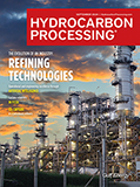Digital Feature: E-methanol: Benefits, process, challenges and a novel technology to produce it
Hydrocarbon Processing (HP) sat down with Andrew Symes (AS), Founder and Chief Executive Officer, OXCCU, to discuss the production, benefits and challenges of e-methanol, as well as a novel, one-set process to produce it.
HP: What are some of the benefits of producing e-methanol from CO2 (carbon dioxide)?
AS: Making methanol from CO2 is a fairly mature process. Unlike most Fischer-Tropsch (F-T) catalysts, the traditional copper/zinc oxide catalyst supported on alumina are widely used at scale today to make methanol from CO (carbon monoxide) and H2 (hydrogen) from coal and gas, also works with CO2 and H2. The reaction is operated at temperatures between 200°C and 300°C and pressures of 50 bar–100 bar. In contrast, traditional cobalt F-T catalysts do not generally work with CO2 and H2, so CO must be made first via the energy intensive reverse water gas shift step before adding more H2. Second, the selectivity is generally high—i.e., there are few byproducts. Finally, despite being a C1 product, it is a liquid at room temperature and pressure rather than a gas, making it easier to use and transport.
HP: Where is e-methanol needed?
AS: As a chemical feedstock, there is no doubt we will need e-methanol alongside bio-methanol to substitute the significant amount of fossil methanol from gas and coal that we use today. It is largely used to make acetic acid and formaldehyde which are used to make specialized plastics, textiles, coatings and resins, as well as its use in clothing, screens, sealants, paints and adhesives. The challenges are that these producers are under pressure with tight margins, with several plants relocating to China. Hopefully, these dynamics will change as margins improve, and the end-use customers of specialty petrochemical products increasingly demand products with lower emissions, even if they are at a premium in the short- to medium-term.
HP: What about the use of methanol as a fuel?
AS: Methanol as a fuel will have more challenges when it is used at 100%. It is currently successfully used as a fuel when blended into gasoline, but only up to strict limits. The big issue is it is very toxic to humans (ingesting as little as 10 mL can cause permanent blindness, and 100 mL can be fatal). This is amplified as it is 100% miscible in water (will absorb water and cannot be easily separated from it), and it has a taste similar to ethanol. It can be denatured, giving it a strong odor and making it impossible to drink, but the risk will always be on the regulators’ minds. It is also toxic to marine life, has low volatility in cold temperatures, burns with a clear flame and can be corrosive to common metals. In addition, since its energy density is low, its performance as a 100% fuel is significantly worse than gasoline or diesel, thus limiting its applications. By itself, it is not suitable as jet fuel.
However, it is still an option for shipping. Ships that can run on methanol and traditional fuels are being built, but the initial methanol momentum fueled by Maersk has cooled, as they have recently announced a hedge with an order for methane ships.1 Overall, it is hard to say whether methanol is the clear winner for shipping fuel since it will face stiff competition from biodiesel, biogas, e-diesel, e-NG (e-natural gas) and e-DME (e-dimethyl ether)—all have different pros and cons, but generally all have less issues with toxicity.
HP: How does methanol compare to ammonia as a fuel?
AS: Certainly, compared to ammonia as a fuel, the toxicity issues with methanol as a 100% fuel are far less. Methanol is liquid at room temperature; ammonia is a gas, and ammonia is far more toxic than methanol, causing fatalities at concentrations of only 2,500 ppm. However, this comparison misses the fact that ammonia is—to some extent—being held back as a fuel at scale largely due to concerns around its toxicity. Excluding toxicity concerns, ammonia as a fuel is appealing, having reasonable energy density (at least when compared to H2), and the advantage of not containing carbon.
Green ammonia will also be needed in huge quantities to replace existing fossil-based ammonia to produce green fertilizer. In addition to reducing emissions, toxicity concerns also matter, as companies, regulators and governments have a duty to protect people and communities. Ultimately, the benchmarks for any new fuel—be it methanol or ammonia—will be the risks and safety standards that are generally accepted today, rather than a comparison between the new fuels themselves.
HP: What about using methanol as an intermediate step to make longer chain deoxygenated hydrocarbon fuels like gasoline or SAF (sustainable aviation fuel)?
AS: E-methanol can be the intermediate step, as it can be upgraded using the MTG (methanol-go-gasoline) process to obtain to C2–C5 olefins on acidic zeolites via DME, and these can then be oligomerized and then hydrotreated to gasoline or jet fuel. However, the challenge is that the additional steps add significant costs, and the final oligomerization step(s) are expensive, fairly new and do not commonly exist at scale.
First, you must make the e-methanol from CO2 and H2. Then, you make the different long-chain olefins via the methanol-to-olefins process. Finally, you produce jet fuel or gasoline via multiple oligomerization reactions and then hydrotreatment. Coal-to-syngas, syngas-to-methanol and then methanol-to-olefins, has been pushed in China at a large scale to reduce the reliance of their domestic petrochemical industry, but this route to produce olefins is largely uneconomical outside of China. It is also significantly worse from an emissions perspective than gas or naphtha-based olefins. In addition, even if these units could be used with e-methanol as the feedstock, the final oligomerization step still requires new units to be built. So, while e-methanol can be made fairly easily with high selectivity via a mature process, methanol has challenges as a 100% fuel. Making long-chain hydrocarbon fuels from methanol requires further capital-intensive steps, as well.
HP: How does Fischer-Tropsch compare as a route to make long-chain hydrocarbons?
AS: F-T is another route to make long-chain hydrocarbons. The key disadvantage here is that in a conventional two-step process, CO2 must first be converted to CO in an energy-intensive reverse water gas shift step before the CO and H2 react via the F-T reaction to make long-chain hydrocarbons. This first step to make CO from CO2 is not easy to scale, especially if driven by electrical heat. The good news is once you have the long-chain hydrocarbons, only hydrotreatment is needed to produce the finished products—these units already exist within refineries. Currently, there is a 5% limit of syncrude that can be coprocessed to produce F-T synthetic parafiinic kerosene (F-T SPK). This is a start, and it will hopefully be expanded in time.
HP: What makes OXCCU’s process different?
AS: OXCCU's novel, one-step F-T catalyst/process via the direct hydrogenation of CO2 combines the best of the two approaches. Unlike the two-step F-T approach, there is no need to first make CO in an energy-intensive first step. The reaction is a single exothermic reaction similar to e-methanol. But unlike methanol—as you already make a range of long-chain hydrocarbons—the expensive further steps to produce jet fuel from methanol are not required, only hydrotreatment. In fact, in several ways, the OXCCU process is not dissimilar to the process of making e-methanol: CO2 and H2 are the inputs to a fixed-bed reactor, both are exothermic reactions, there is a recycle loop to boost conversion, and you end up with liquid products. The difference is in the OXCCU case, where the liquid is long-chain hydrocarbons, not methanol, which is far easier and cheaper to produce jet fuel from, requiring significantly less pressure.
HP: What does the future role of methanol in the creation of sustainable fuels?
AS: We will need e-methanol to displace fossil methanol which is used to make chemicals and plastics. We need these customers to encourage the e-methanol market, and we need large projects to supply them. However, methanol's properties will mean it will face challenges when used as fuel at 100%, especially when compared to long-chain hydrocarbons. While using e-methanol as an intermediate step to make long-chain hydrocarbons is possible, it could face cost challenges due the amount of new units required, especially when compared to long-chain hydrocarbons produced via OXCCU’s one-step F-T process followed by hydrotreatment.
LITERATURE CITED
1 Shen, C., “Maersk hedges on LNG amid methaol’s bumpy road,” Lloyd’s List, July 9, 2024, online: www.lloydslist.com/LL1149842/Maersk-hedges-on-LNG-amid-methanols-bumpy-road







Comments